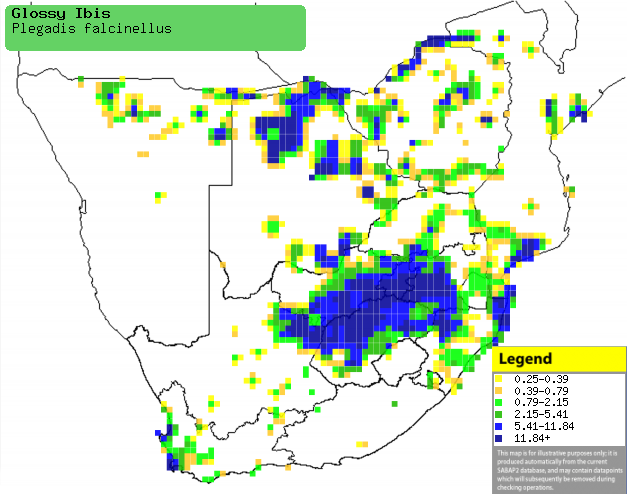Plegadis falcinellus (Glossy
ibis)
Glansibis [Afrikaans]; Zwarte ibis
[Dutch]; Ibis falcinelle [French]; Brauner sichler [German]; Ibis-preto
[Portuguese]
Life
> Eukaryotes >
Opisthokonta
> Metazoa (animals) >
Bilateria >
Deuterostomia > Chordata >
Craniata > Vertebrata (vertebrates) > Gnathostomata (jawed
vertebrates) > Teleostomi (teleost fish) > Osteichthyes (bony fish) > Class:
Sarcopterygii (lobe-finned
fish) > Stegocephalia (terrestrial
vertebrates) > Tetrapoda
(four-legged vertebrates) > Reptiliomorpha > Amniota >
Reptilia (reptiles) >
Romeriida > Diapsida > Archosauromorpha > Archosauria >
Dinosauria
(dinosaurs) > Saurischia > Theropoda (bipedal predatory dinosaurs) >
Coelurosauria > Maniraptora > Aves
(birds) > Order: Ciconiiformes
> Family: Threskiornithidae
Distribution and habitat
Occurs on every continent except Antarctica; in southern
Africa, it is
locally common in central and southern Mozambique, Zimbabwe, northern and
southern Botswana, northern Namibia and central and south-western South Africa.
It generally prefers shallow, freshwater lakes and rivers, flood plains,
riparian marshes, seasonal pans, flooded grassland, irrigated farmland,
estuaries and open grassland in parks and farms. When breeding, it is largely
restricted to swamps with stands of tall sedges and reeds.
|
 |
|
Distribution of Glossy ibis in southern Africa,
based on statistical smoothing of the records from first SA Bird Atlas
Project (©
Animal Demography unit, University of
Cape Town; smoothing by Birgit Erni and Francesca Little). Colours range
from dark blue (most common) through to yellow (least common).
See here for the latest distribution
from the SABAP2. |
Movements and migrations
In southern Africa it can be sedentary or
nomadic and dispersive, as it often follows rain fronts which
transform arid habitats into temporary oases.
Food
It mainly eats insects, doing most of its foraging in
flocks of at least 30-40 individuals, walking in shallow water or soft ground,
probing the soil and snapping up prey on the surface. It occasionally follows
Nile crocodiles (Crocodylus niloticus) and Hippopotamuses (Hippopotamus
amphibius), catching any animals disturbed in their wake. The following food items have been recorded
in its diet:
- Invertebrates
- insects
- crustaceans
- molluscs
- worms
-
spiders
- Vertebrates
- frogs
- lizards
- small mammals
Breeding
- Monogamous, breeding in colonies of roughly 3-200 nests, often alongside
other birds such as herons, African spoonbills,
cormorants,
African darters and other
ibises.
- The nest is mainly built by the female with material provided by the
female, consisting of a small platform of sedge stems, reeds, sticks and
branches, lined with grass, leaves and other soft material. It is typically
placed in a dense patch of rushes or reeds, occasionally on the ground on a
large reedbed island.
- Egg-laying season is from September-February in South Africa and from
November-April further north in southern Africa.
- It lays 2-4 eggs, which are incubated by both sexes by both sexes for
about 20-23 days.
- The chicks are brooded intensely by both parents for the first two weeks
of their lives, after which they form crèches in nearby reedbeds, although
they still return to the nest to be fed. They can fly and self feed after they
reach 42 days old, becoming fully independent roughly a week later.
Threats
Not threatened in southern Africa, although its range has
contracted in much of Eurasia.
References
-
Hockey PAR, Dean WRJ and Ryan PG 2005. Roberts
- Birds of southern Africa, VIIth ed. The Trustees of the John Voelcker
Bird Book Fund, Cape Town.
|
